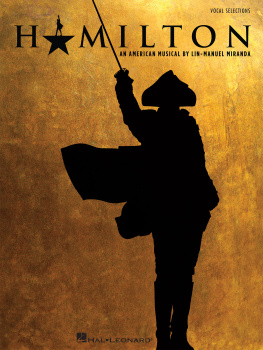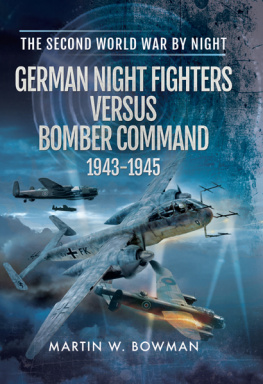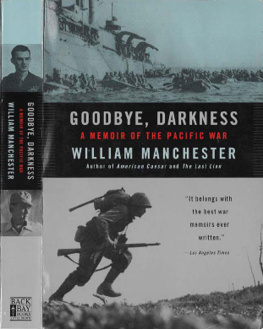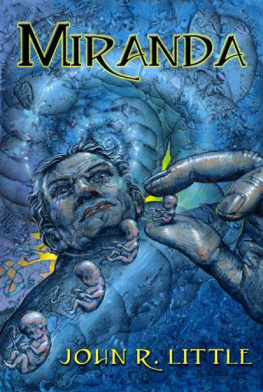Miranda - Pacific and CBI Night Fighters: Air War in the Darkness - Volume One
Here you can read online Miranda - Pacific and CBI Night Fighters: Air War in the Darkness - Volume One full text of the book (entire story) in english for free. Download pdf and epub, get meaning, cover and reviews about this ebook. year: 2022, genre: Non-fiction. Description of the work, (preface) as well as reviews are available. Best literature library LitArk.com created for fans of good reading and offers a wide selection of genres:
Romance novel
Science fiction
Adventure
Detective
Science
History
Home and family
Prose
Art
Politics
Computer
Non-fiction
Religion
Business
Children
Humor
Choose a favorite category and find really read worthwhile books. Enjoy immersion in the world of imagination, feel the emotions of the characters or learn something new for yourself, make an fascinating discovery.

- Book:Pacific and CBI Night Fighters: Air War in the Darkness - Volume One
- Author:
- Genre:
- Year:2022
- Rating:4 / 5
- Favourites:Add to favourites
- Your mark:
- 80
- 1
- 2
- 3
- 4
- 5
Pacific and CBI Night Fighters: Air War in the Darkness - Volume One: summary, description and annotation
We offer to read an annotation, description, summary or preface (depends on what the author of the book "Pacific and CBI Night Fighters: Air War in the Darkness - Volume One" wrote himself). If you haven't found the necessary information about the book — write in the comments, we will try to find it.
Pacific and CBI Night Fighters: Air War in the Darkness - Volume One — read online for free the complete book (whole text) full work
Below is the text of the book, divided by pages. System saving the place of the last page read, allows you to conveniently read the book "Pacific and CBI Night Fighters: Air War in the Darkness - Volume One" online for free, without having to search again every time where you left off. Put a bookmark, and you can go to the page where you finished reading at any time.
Font size:
Interval:
Bookmark:
Pacific and CBI Night Fighters
Air War in the Darkness
Volume One
Contents
The Japanese Aggressor (January 28, 1932, to August 15, 1945)
USAAF
Boeing P-26 B
Douglas P-70
Lockheed P-38
Douglas XA-26A
North American B-25 H
Northrop P-61
US Navy
Lockheed PV-1
Grumman TBM
Chance-Vought F4U-2
Grumman F6F-3N/5N
RAAF
Supermarine Spitfire Mk. VC
Fleet Air Arm
Fairey Firefly FR. Mk I/NF. Mk I/ NF. Mk II
Royal Air Force
Bristol Blenheim Mk. IF
Bristol Beaufighter Mk. IF & Mk. VIF
Hawker Hurricane Mk. IIB (NF) & Mk. IIC (NF)
Imperial Japanese Army
Kawasaki Ki.45 Toryu
Schrge Musik
Mitsubishi Ki.46 Shin Shitei
Kawasaki Ki.60/Ki.61/Ki.100 Hien
Nakajima Ki.84 Hayate
Kawasaki Ki.102
Nakajima Ki.201 Karyu
Imperial Japanese Navy
Nakajima J1N1 Gekko
Mitsubishi A6M2, A6M3, A6M5 and A6M5-S Zero Sen
Mitsubishi J2M3 and J2M4 Raiden
Yokosuka D4Y Suisei
Nakajima C6N Saiun
Kawanishi Kyokko , Nakajima Byakko and Kugisho Tenga
Aichi S1A Denko
Bibliography
The Japanese Aggressor (January 28, 1932, to August 15, 1945)
After the abolition of feudalism in 1871, Japan hastened to create an industrial monster that quickly exceeded the very few natural resources of the country. The inertia generated by the machines dragged the Japanese into a militaristic spiral that only a major defeat could stop.
In 1895 they annexed Taiwan, in 1905 they defeated Russia and in 1910 they invaded Korea to seize large amounts of coal. To save Japan from the effects of the Great Depression the Imperial Japanese Army occupied Manchuria in 1931, giving the Japanese industry access to its numerous natural resources of iron, aluminum, coking coal, soybeans, and salt.
In 1933 Japan occupied the Chinese province of Jehol and initiated a large-scale warfare in 1937 that alarmed the international community. Following the clash with the Soviets in Nomonhan, Japan lost access to oil concessions from Northern Sakhalin.
When France capitulated in June 1940, Japan moved into Northern French Indochina and the U.S. Administration reacted by banning the export of essential defense materials: aviation motors, high-octane aviation fuel, lubricants, iron and steel scrap. The embargo was expanded in July 1941 to all grades of oil and the British and the Dutch followed suit, embargoing exports of copper, tin, bauxite, rubber and petroleum to Japan from their colonies in Southern Asia. The Allies were putting Japan in an untenable position that would force oil-starved Japan to seize the oil fields of the Dutch East Indies.
To do this, the Imperial Japanese Army (IJA) should neutralize the powerful British defenses in Singapore and the Imperial Japanese Navy (IJN) should make landings in the Philippines defended by the Americans. The war would be inevitable, the Allies knew, but they did not expect the attack to succeed and were surprised when only 17 Mitsubishi G4M bombers from the IJN Genzan Kokutai managed to sink two of the most modern British battlecruisers in a few minutes.
Shortly thereafter eighty-seven Nakajima Ki.27b and fifty-nine Nakajima Ki.43-Ia from the IJA exterminated the 114 Brewster Buffaloes and 51 Hawker Hurricanes defending Malaya, pushing the Brits back to Sumatra and Burma initially and then to Ceylon and Australia. At Pearl Harbor, the Philippines, Java and Ceylon the Mitsubishi A6M2 Zero-Sen sowed terror by annihilating most of the P-35, P-36, P-40, Hurricane Mk.II, Curtiss CW.21B Demon and Fairey Fulmar fighters that opposed them.
The exceptional dog-fight capabilities of the Japanese fighters and the ferocity and experience of their pilots had been virtually ignored by Allied intelligence officers... How did that happen?
The Nakajima Ki.27 Nate (Abdul) had been operating in China since March 1938 and several specimens had been captured and tested by Chinese and Soviets. His performances were well known in the West, but the archaic aspect of his airframe with fixed undercarriage (inspired by that of the 1934 Northrop XFT) made the Allies think that it was a technologically outdated design.
In fact, under the protection of 600 Ki.27 fighters, the IJA conquered 90 percent of the territories occupied during World War II. The airplane was not examined by Allied experts until the capture of a Ki.27-Otsu of the 77th Sentai in Burma in April 1942.
The Mitsubishi A6M Zero Sen (Zeke) was also unknown. In the spring of 1941, the Chinese managed to shoot down an A6M2 Type 11 over Chengdu and very accurate data sheets and three-view drawings were delivered to the U.S. Navy Department and the U.S. War Department, but experts did not consider the data to be credible and the report was ignored.
The Zero was designed to meet the IJN specification of 19 May 1937 that required a fighter capable of flying at more than 500 km/h, with an exceptional range, to escort the bombers under the specific conditions of the war in China. Its construction was only possible by adopting a retractable landing gear, based on that of the prototype Chance Vought V.143 acquired by the Japanese in 1937. The armor and all the auxiliary equipment of a naval fighter were detached, until obtaining an aircraft that weighted 25 per cent less than the Grumman F4F, though retaining its powerful weaponry.
No one in the West believed that a fighter with these characteristics could exist until the attacks of Pearl Harbor, Philippines, and Java. In July 1942, American experts were able to examine a Zero that had been captured in Akutan Island, managing to identify the weak points of their construction, a vital information that saved U.S. airmen lives and that was used to design the Grumman Hellcat .
On the other hand, the Nakajima Ki.43 Hayabusa (Oscar) was totally unknown outside Japan. The success of the Ki.27 had delayed the start of its production until April 1941 and only 40 units had entered service in December. A complete surprise to the Allies, which initially mistook it for the Zero, the Japanese Army decided to reveal its existence in April 1942. Equipped with butterfly combat flaps and weighting 33 per cent less than the P-40B, the Ki.43 was able to out-maneuver the Buffaloes, Hurricanes and Tomahawks . The first unit was captured at Chittagong in the spring of 1942. Tested by the Australians, the Chinese and the Americans, it revealed weaknesses in combat: its lack of pilot armour and self-sealing fuel tanks. The Allies soon developed hit and run tactics that could be used successfully against it.
The Japanese R/T devices never worked air-to-air, the pilots used to uninstall them to save weight and communicated with movements of the wings. Their obsolete telescopic gunsights restricted the peripheral vision and many Ki.27 and Ki.43 pilots were surprised by hit and run attacks during the strafing of an airfield. Following initial successes, achieved through attacks with local numerical superiority against 2nd line Allied Fighters, the Japanese sword blunted in Midway, Guadalcanal and New Guinea.
The Allies reacted by designing and building thousands of Hellcats, Spitfires, Seafires, Corsairs, Mustangs, Thunderbolts and Lightings advanced fighters in record time, while the same 1941 models continued to be manufactured in Japan.
With the arrival of the second generation of Allied fighters to the Far East, during the first months of 1943, Japan suffered heavy air losses.
The Allied air superiority in day light forced the Japanese bombers to perform night attacks under the cover of darkness, to prevent annihilation.
The twin engine heavy fighters Nakajima J1N1-Hei Gekko (Irving) and Kawasaki Ki.45-KAI-Ko Toryu (Nick), were modified as J1N1-Hei-KAI and Ki.45-KAI-Otsu night intruders.
Next pageFont size:
Interval:
Bookmark:
Similar books «Pacific and CBI Night Fighters: Air War in the Darkness - Volume One»
Look at similar books to Pacific and CBI Night Fighters: Air War in the Darkness - Volume One. We have selected literature similar in name and meaning in the hope of providing readers with more options to find new, interesting, not yet read works.
Discussion, reviews of the book Pacific and CBI Night Fighters: Air War in the Darkness - Volume One and just readers' own opinions. Leave your comments, write what you think about the work, its meaning or the main characters. Specify what exactly you liked and what you didn't like, and why you think so.









